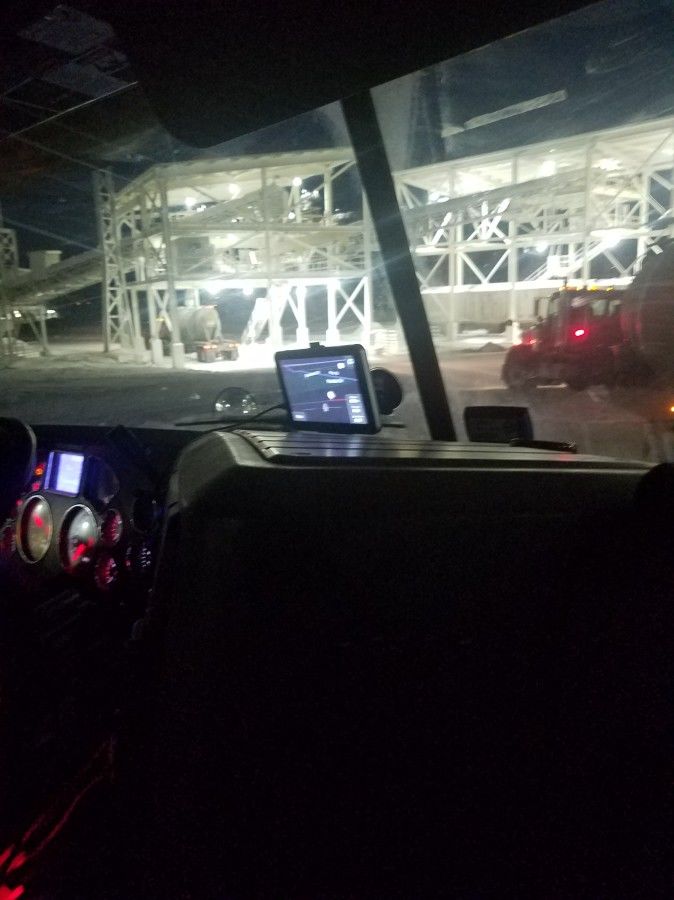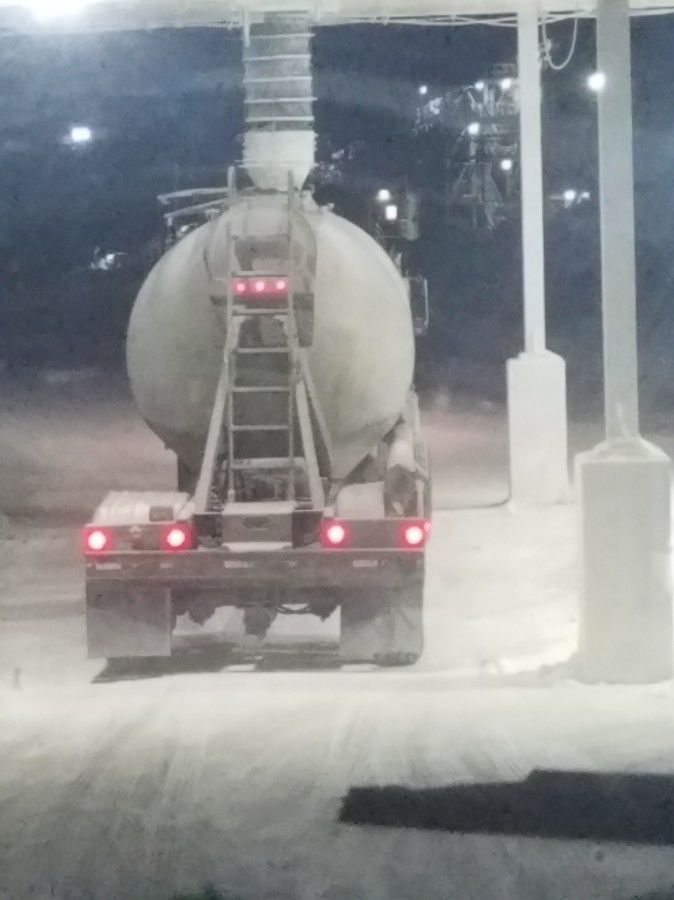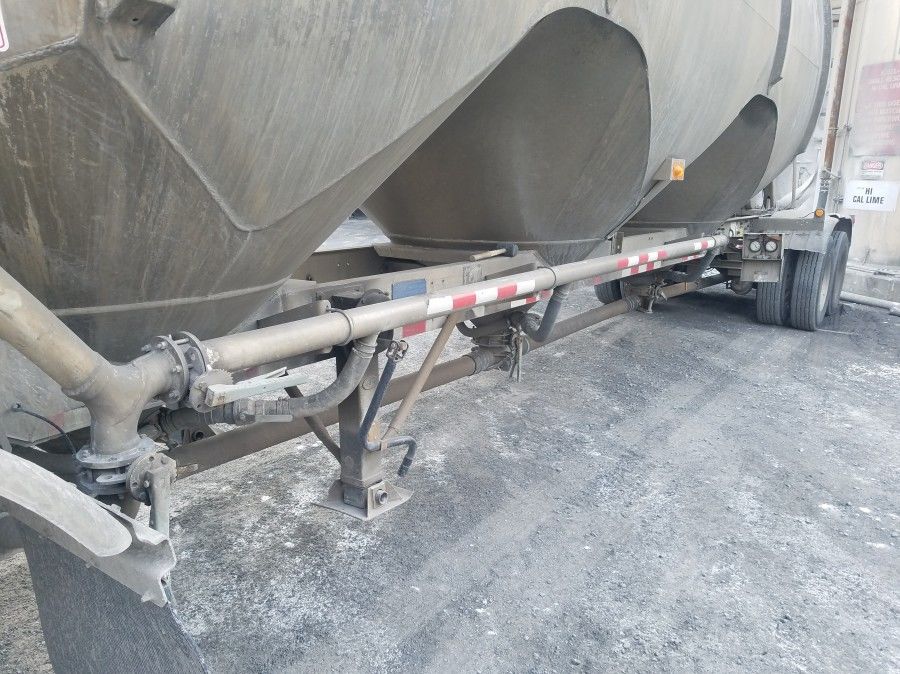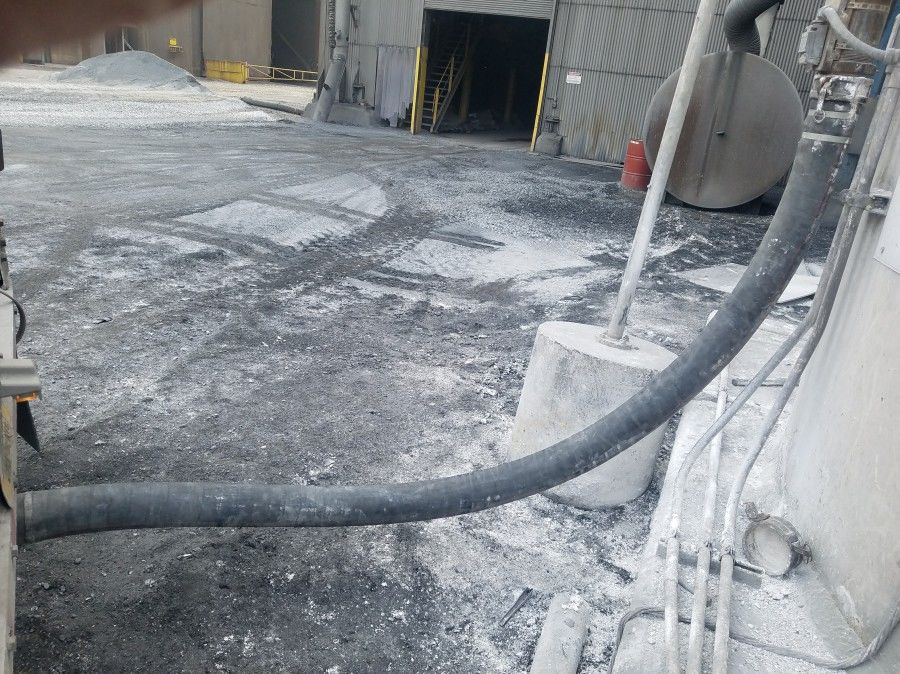My Pneumatic Tanker Job
Topic 22254 | Page 1
Thursday i met my trainer at 4 am for my observation day of training, day 1. I think they do this to give new people a chance to see what the job is and what a normal day is. That way if they don't think they will like the job or be able to do it they can bail early on.
We drove down to a quarry near Martinsburg, WV to get a load of pebble limestone, trip took us around 2 hours to get down there. Once we were loaded we had to go to an incinerator plant in Chester, pa. From what I was told they mix the lime with the ash from the garbage and it is then brought to landfills and such. Pulled around the back and angled the trailer a little bit towards the hose hookup for the silo. There is a 20 ft soft side hose and what seems like a 10 ft hose. He hooked a hose from the front of the tank to a blower that is run by the pto unit that forces air into the tank system. The 20 ft hose was hooked up to a tube at the back of the trailer and the other end was hooked up to a tube for their silo. Once we were empty we headed back to the yard and were done by 2:30. They have their own fuel islands so the tanks are filled at the end of everyday so your ready to go the next day.
The tank has a couple valves and pipes. There's a blowoff valve to release air pressure, a valve to push air into the top of the tank and build downward pressure, a valve to supply air to the supply line that runs the bottom of the tank and push the product out the back through the tubes, valve for aerators that vibrate each pocket and keep the product loose and flowing. Each pocket of the tank has a valve at the bottom that drops product into the supply line. You control how fast the product comes out with how much you open the valve. Tank pressure and line pressure vary per place but usually need to keep both between 10 and 15 psi and they should both be at the same pressure.
My trainer is a cool guy we have the same tastes in music and few other things in common. He was a paramedic for 15 years before going to trucking. Did something like 5 years OTR and has been with this company for a couple years and has trained many before me that are still working at the company.
OTR:
Over The Road
OTR driving normally means you'll be hauling freight to various customers throughout your company's hauling region. It often entails being gone from home for two to three weeks at a time.
HOS:
Hours Of Service
HOS refers to the logbook hours of service regulations.OWI:
Operating While Intoxicated
OOS:
When a violation by either a driver or company is confirmed, an out-of-service order removes either the driver or the vehicle from the roadway until the violation is corrected.
Friday we had 2 loads to run and needed to switch out the tank for the second load. Both were out of a quarry in Asheville, pa. In the quarries and at customers we need to wear reflective vests, hard hats, and safety goggles.
Load 1 was something called hydrate (not sure what it was exactly but it was some fluffy, light stuff). We get to the quarry, weigh in on the scale, get our pick ticket and get where we need to load. It's a self serve load so we need to drop the shute into the top of the tank and press a button to drop the product in. I got to open the top hatch on the tanker since my safety harness was setup now. There is an overhead safety line that hooks to a d-ring on the back of the harness so if you fall it isn't down to the ground, still wouldn't be fun and I don't plan on ever finding out. I get hooked up and climb the ladder on the back of the tank. There are 4 hatches on this tanker and the trainer instructs me to open the 2nd one down. We were getting 15 tons and since it was a light product you only need 1 hatch and it will fill into the rest of the tank. Normally if we were getting a full load you would open the next hatch so you can see when the tank gets full. Since we were not on a scale the trainer used a pressure gauge on the back of the truck to judge when we were getting close to weight. Once we were done he backed the truck up and I climbed back up to lock the hatch down. We scale out, get our BOL and head to Phoenixville, PA to deliver to a water treatment plant (60ish miles to get there). Not a lot of room getting to this plant but once you get to the silo you have all the room to move around. Back up to the silo, hook up the hoses and get the pressure flowing. This light product you start with 1 pocket and when that one starts running out and the pressure start to drop you open the second pocket and close the 1st one halfway help clear it out. Repeat through to the end. Once they are all closed let the pressure in the tank build to push leftover down and open each pocket to get the leftover out (clean out). Shut PTO off to stop the blower and open the blow down valve halfway to let the pressure out of the tank. Step on the hose to make sure its not pressurized still and then disconnect from the trailer and silo. Put the hose away and cap the pipe on the trailer. Disconnect the blower hose and cap the blower. Took us a little over an hour to unload. Back to the yard we go to switch the tank out.
Load number 2 picking up some lime fines in Anneville to deliver to a water treatment plant in coatesville, pa (50ish miles away). This trailer has 3 pockets and since the product is heavier I had to hook up and open the 1st and 3rd hatches. This is loaded by someone in the office. Set our CB to the proper channel and they let us know when to stop for the shute and we let them know when to stop the product flow. He drops into the first pocket and starts loading. Watching a pressure gauge on the dash we can see the weight in the drive tandem to let him know when to stop. Get to around 25k lbs we my trainer tells the guy we are set on the CB. He keeps filling us, weight is climbing. Tell him to stop a couple more times and nothing. I hop out and go in to get him to stop loading us. At this point we are 30k on the drives and need more product in the rest of the tank. Pull up to the 3rd pocket and fill until we hit 34k on the drives. Inside the tank there are short walls and it opens up a little toward the top. To try and shift some of the product from the 1st pocket my trainer pulled up on a slight slope, backed up and hit the brakes after a couple times we decided to give it a shot. Washed the top of the tank and headed for the scale, pull onto it and we weigh in at 77k. Need more product. Turn around and drive back up. The operator can see the scale from where he is and knew we were coming back up. Pull in, hook up the harness and open the middle pocket this time and load up some more. Blew the air horn this time to make sure he stopped. Hit the scale and weigh in at 79,960. damn that's close. Get out BOL and head to Coatesville. You could feel how heavy the drives were the whole way there but still not a bad ride. Easy silo to hook up to here and I was able to work the valves and hook up the hoses with some coaching. Heavier stuff like the limestone is unloaded 1 pocket at a time and not fully open, pressure was around 12-15 psi for this unload and took around 45 minutes. Paperwork is filled out after you start the unload and have it flowing since you have time between actually doing anything. Once we had everything closed up and blow down open we went back to the yard to end the day. Not much for miles but still ended up being a 12 hour day because of the issue with the load.
I actually had fun today doing all of this. The hardest part will be remembering how the different product unloads without getting everything clogged up. My company ID number came through so I am cleared to start driving. First with empty tanks from the last unload to the yard and working up from there.
Tandem:
Tandem Axles
A set of axles spaced close together, legally defined as more than 40 and less than 96 inches apart by the USDOT. Drivers tend to refer to the tandem axles on their trailer as just "tandems". You might hear a driver say, "I'm 400 pounds overweight on my tandems", referring to his trailer tandems, not his tractor tandems. Tractor tandems are generally just referred to as "drives" which is short for "drive axles".
HOS:
Hours Of Service
HOS refers to the logbook hours of service regulations.OWI:
Operating While Intoxicated
This is a very interesting read. Sounds like a lot of attention to detail.
Day 3, start of a new week. 2 loads today, 1 we have to go get loaded for and the other was a preload. Both went to a steel mill in steelton, pa and were loads of 2 different forms of limestone. 4 am start and headed down to clearbrook, va (same place we loaded the previous Thursday) picking up some pebble lime. Those steel plants and pretty interesting to watch the operation of. Can see molten product moving between the warehouses. We back in and can close enough to use the 10 ft hose which helps unload a little quicker. Lime gets unloaded 1 pocket at a time, 10-15 psi. I did most of the unload and was able to get some tips and tricks for certain situations. Not sure how long the unload was but not terrible, maybe 45 min to an hour. We weighed out and went to the office to get the BOL signed. Since I'm cleared to drive now the trainer let me drive back with the empty trailer. I will say that the automatic transmissions are a lot easier since you can just focus on the road, I'm a fan. Get back to the yard and drop the trailer we have and hook up the preload and give it a good pretrip. One of the hoses was missing a gasket but my trainer carries extras because it is common. Head back to steelton with our load of lime. Trainer backs it in and tells me he wants to see what I can do with the unload, well ok then let's do this! Took my time and went through the routine and didn't have any issues unloading. I know it wasn't the best time for unloading but it worked and helped me really nail down the steps needed and working the air valves. Finish up and weigh out, I took the BOL in and chatted with the office people for the signature. Off we go and I get to drive again back to the yard. We get there and drop the trailer we have and park at the fuel island where I was shown how to work the pumps and we do a post trip in the tractor and drop off the paperwork in the office. Done by 2:30.
HOS:
Hours Of Service
HOS refers to the logbook hours of service regulations.
Cool! Thanks for sharing this.
New Reply:
New! Check out our help videos for a better understanding of our forum features

















Preview:
This topic has the following tags:
Advice For New Truck Drivers Distracted Driving Driver Responsibilities Mountain Driving On The Road In Training Photos Tanker Truck Driver Salary Truck Driver Training Truck Driving Stories











 TT On Facebook
TT On Facebook
This week I started working at FT silfies & jp donmoyer working in their dry bulk tanker division (they have dry van but it's not their main business). They employee around 200 drivers and is a family owned company affiliated with Quality Carriers. Everyone has been very nice and laid back so far. While I was waiting for my road test the grandson of the founder actually came out and introduced himself and talked with me a little.
Since this side of trucking is little known about i thought I would try to share my experience with it and what the work is.
Little about what I know so far. Most of the trucks are automatic macks, volvo, freights and maybe some kenworths. They do have some 10 speed but the majority are autos. Tanks are 42 ft pneumatic (uses air pressure to unload) and total length of truck and trailer comes to around 58 ft depending on truck wheelbase and around 13 ft high. Because of the shorter length I have noticed from watching that the trailer doesn't off track nearly as much as the van trailers we pulled in school.
The product we haul is out of quarries. Cement powder, various forms of lime stone, feed, coal, etc. And this depends on what terminal area you are in. Training and orientation is paid $130 a day.
Monday I came for a road test and went for my drug screen.
Tuesday and Wednesday were orientation days. Watching company videos from quality carriers and covering the company procedures. Lunch was provided both days. We also received all of our safety gear. Hard hat, gloves, safety goggles, safety belt and lanyards and I was given a safety harness since some of the quarries I will have to go to do not have the safety rack system for the top of the tanks. I met my dispatcher and got the information for who my trainer was and when to meet him on thursday.
Terminal:
A facility where trucking companies operate out of, or their "home base" if you will. A lot of major companies have multiple terminals around the country which usually consist of the main office building, a drop lot for trailers, and sometimes a repair shop and wash facilities.
Dispatcher:
Dispatcher, Fleet Manager, Driver Manager
The primary person a driver communicates with at his/her company. A dispatcher can play many roles, depending on the company's structure. Dispatchers may assign freight, file requests for home time, relay messages between the driver and management, inform customer service of any delays, change appointment times, and report information to the load planners.Dry Van:
A trailer or truck that that requires no special attention, such as refrigeration, that hauls regular palletted, boxed, or floor-loaded freight. The most common type of trailer in trucking.